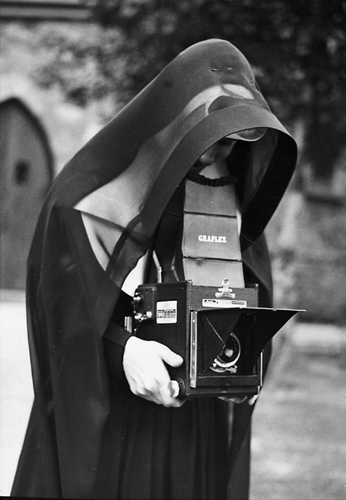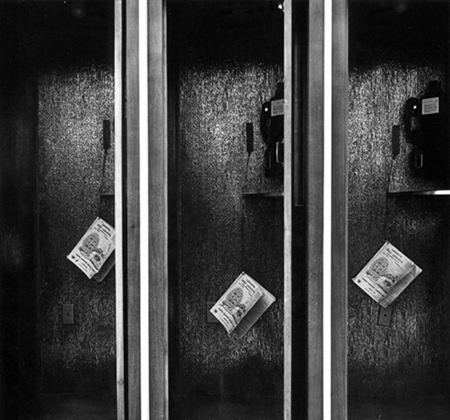
Sister Mary Margaret; 1952, by Richard Zakia, Rochester Institute of
Technology, NY, student of Leslie Stroebel
1
“Hey Teach…': Two Histories of Changing Direction and Mindset
“You cannot teach a man anything; you can only help him find it within himself. ”
Galileo Galilei
From Richard D. Zakia
Some of us enter teaching through the front door and others, like myself, through the back door. I had never entertained the desire to become a teacher but feel fortunate and blessed for having spent 34 years working with students and assisting them in their learning. My interest in teaching was fostered by teachers who I have had, particularly my college teachers. I find it interesting to journey back and visit those years as a student and recall the influences some teachers have had on me.
After discharge from the Navy in 1946, and then again from the reserves in 1952, I applied to the University of Rochester. During my interview, the admissions officer looked at my high school record and bluntly told me that I was not college material. Disappointed and discouraged but not defeated, I decided to try the Rochester Institute of Technology (RIT). I had the good fortune of meeting with the Director of the Photography Department, a warm and benevolent man who was willing to accept me on probation.
It was as a student at RIT that my latent interest in teaching began to surface. Credit must be given to the faculty at that time and to the school's student-friendly environment. My teachers, I discovered, had different personalities and each had a different approach to teaching, but all seem to have the student's interest at heart. Ken Bain, in his book What the Best College Teachers Do, writes that contrary to popular beliefs, a teacher's personality plays little to no role in his or her effectiveness as a teacher. I certainly found this to be true in my experiences as a student.
Here is a brief profile (alphabetical) of each of my teachers; they not only motivated me to learn but also to become interested in teaching, although I did not realize it at the time:
Ralph Hattersley—A person who was laid back, constantly searching and questioning photography and life, and posing thoughtprovoking questions to students.
C.B. Neblette—A somewhat shy Virginia gentleman, Neblette was the Director of the school and also taught a course in the History of Photography from a technical point of view. He was an outstanding and innovative administrator. With the faculty's approval, he had the students elect their own representative to attend all faculty meetings. This made me realize that students were indeed an integral part of the learning process and should have a voice. I was fortunate enough to have been a representative for a year.
Beaumont Newhall—A quiet, thoughtful person and a scholar who projected a deep love for the history of photography and for photography as an art form.
Al Rickmers—He taught statistics, something in which students were not the least bit interested. What did it have to do with photography? Rickmers realized the lack of interest and would spend the first class session on selling the idea of how relevant it was, not just to photography but also to life.
Bill Shoemaker—A roly-poly, jolly teacher who often used interesting metaphors to lessen the pain of having to learn chemistry.
Les Stroebel—Taught how to be well prepared for class and for labs, and how to design test questions that are valid and fair and to grade accordingly.
Hollis Todd—He projected confidence as a teacher and would encourage students to ask questions in class. Once a student challenged what he had written on the blackboard, which surprised the entire class, since we were only freshman. Todd looked at what he had written, then turned around and, looking straight at the student, said, “You are right, I was wrong. ” To this day, I have never heard a teacher honestly admit such a thing ina classroom. Another experience I shall never forget is my great difficulty with Analytical Geometry. I was really struggling to get a C grade on the final, which would have taken me off probation. I knew I did poorly on the final test and expected a D grade at best. Todd seemed to be aware of my concern and that I had really been struggling in the course and giving it my best. To my delight and surprise, he gave me a C-minus instead of the D that I probably deserved. From this I learned that if you have to make a tough decision and might err, err in favor the student.
Minor White—A soft-spoken gentleman, a fine art photographer, author, poet, and publisher of Aperture. I learned how to spend time looking at and carefully studying photographs and sequencing them, opening up to the other arts, including dance and Eastern ways of thinking.
A common thread with all these teachers was an openness to teaching, learning, and inquiry. If a student wanted to present some relevant material to the class, he or she was encouraged and invited to do so. On several occasions I did just that, and looking back at this, I now realize my latent interest in teaching was fermenting.
After graduating with a BS in Photographic Science, I worked at Kodak for a few years in what was then called the Color Technology Division. It was a peach of a job, a great place to work, and carried many benefits. However, something was missing. I soon realized I was more interested in teaching than I had thought.
In 1958 I was invited to join the Department of Photography at RIT, now called the School of Photographic Arts and Science. In my first year of teaching, Hollis Todd was my mentor and he was most helpful. After a few months of teaching, I felt that something was not right and began to question my teaching. I soon realized that I had been so influenced by my mentor that I was unknowingly trying to emulate him. It wasn't working. One has to be true to oneself. (A similar problem occurred with some of Minor White's students. When they graduated and went on to do their own work, their photographs looked much like Minor's.)
In my second year of teaching, I found myself continually questioning my role in the classroom. What was my function as a teacher? How do students learn? What is the purpose of testing and what are we measuring? Such questioning led me to search for answers in a graduate program in education psychology at the University of Rochester. Ironically, I received my doctorate from the school that had first rejected me.

Purdue Union; 1963, by Glenn Rand, Purdue University, IN, student of Vernon Cheek
From Glenn M. Rand
It was a pivotal moment in my travels through education. I was teaching in a small college in the mountains of Virginia and had been transplanted from teaching for six years in a Big Ten university. After being in my job for a month, a student approached me and cut to the heart of what my profession was to become.
In a conversation about why we were at the college the student stated, “Hey Teach, learn me.” There was no answer, just a moment that the whole process became clear. He was there to learn and my role would be to assist him in that quest. Before that point the word “teach” was an active verb, but the student put it into its proper place, as a noun. Teach was a role, not an activity, and certainly not the outcome.
Prior to this point of clarity my direction was to be a “teacher.” That meant that the teaching was an end point. Teaching represented a goal, employment, and a purpose. It far surpassed the concepts involved in the education of the students. The outcome of teaching was education for others, and, of course, education would necessarily happen if the teaching were strong. The teaching method would override anything else in the situation. The need for education in that form was a well thought out process of presentations, materials, and methods. It had been an issue of finding the most successful way of presenting the content of the courses assigned to me. Thus preparation and presentation were the primary sources of teaching, and this misconception is widespread in all education today. As a colleague erroneously told me many years later, he “needed only two weeks head start on the students and he could teach anything.”
Then the statement… “Hey Teach, learn me”: Presentations, materials, and methods no longer sufficed to evaluate the educational process, and actually were very far behind the real measure, students'learning. Though I might be involved in the students' learning, I would not be able to accomplish learning by any student by myself, regardless of my talent as a teacher.
When “Teach” became a noun in the process, it was obvious that my role in education—as a valve, through which learning was poured into the students during the activity of teaching—stopped, and changed to a support role, in which learning was a process that the students would pursue. Like a shot, the critical issue was no longer only how well the materials were presented nor the content. It became instead a search for what would be learned. Now the success of what I was doingdepended critically on others' outcomes compared to their goals, not on my activities alone.
At that point I had an unusual benefit to finding a new paradigm for learning and teaching that never seemed an advantage before. Having been diagnosed with a learning disability early in life, my increase in knowledge required the circumvention of traditional education. Particularly it not only depended on classroom teaching but also on figuring out how to learn. For years, I used others to “learn me.” Many taught to me, and while their efforts may not have infused me with knowledge, some helped me learn.
The issue became realizing that learning happens for individuals in different ways, not based on a cookie cutter approach that uses the same tool for each student, for learning is a desire that has many paths expressed by many people. The goal is not to follow someone else's path, their teaching, but to use any good path or a number of paths that get you to an individual goal. Success is not following solely predetermined curricula or outlines, but the desire to learn needs to be turned into the kernel that grows into knowing…the valuable thing in education is learning, not teaching.
In this light, education as a profession becomes a means of encouraging and inspiring others to see. Inspiration alone can lead to seeking out other routes to learning, and the role of “Teach” is to provide those inputs and methods that can create learning, not to look at the method being taught as the only way to show learning. The challenge is in taking any eagerness the individual presents and then looking for ways to turn the energy created by the inspiration into methods for learning. Our methods are only tools and we must understand that just as at times, in photography, we use a reflective meter, there are other times that incident metering will do a better job—this is also a strategy for our roles in the learning of others. Clearly, some methods work for some individuals while others do not. To assist our students we need to change the way we look at teaching and the many technologies we use to teach. Each is a path that some will find helpful, but none fits all.
In photography, just as technology is a tool for making images, teaching is the tool for learning. Some tools are better for some than others. Our job is to assist the learners by making available various learning opportunities to our students.
